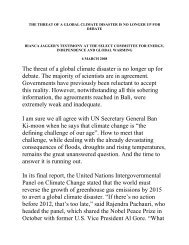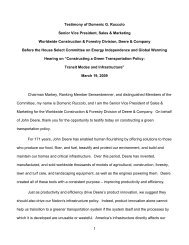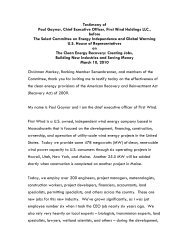Tom Troxel - The Select Committee for Energy Independence and ...
Tom Troxel - The Select Committee for Energy Independence and ...
Tom Troxel - The Select Committee for Energy Independence and ...
You also want an ePaper? Increase the reach of your titles
YUMPU automatically turns print PDFs into web optimized ePapers that Google loves.
1) Management Strategies <strong>for</strong> Sequestration - Forests play a crucial role when considering ways to address<br />
the increase in atmospheric carbon dioxide levels <strong>and</strong> potential climate change. Forests are better at storing<br />
carbon than any other l<strong>and</strong> cover. It is estimated that U.S. <strong>for</strong>ests sequester about 200 million metric tons<br />
of carbon per year, which offsets about 10% of the industrial emissions of greenhouse gases.<br />
Although there is debate on this issue, it seems clear from modeling studies that, in the long run, properly<br />
managed <strong>for</strong>ests that incorporate a sequence of harvests result in more carbon sequestered than a <strong>for</strong>est left<br />
unmanaged. This is because rapidly growing young <strong>for</strong>ests are more efficient in carbon sequestration. Old<br />
<strong>for</strong>ests store more carbon, but as they age <strong>and</strong> are taken over by insects <strong>and</strong> disease the net uptake of carbon<br />
can diminish to zero as carbon lost in respiration <strong>and</strong> decomposition becomes similar to the rates of carbon<br />
uptake. Harvesting results in an immediate decline in carbon storage, but the significance of this depends<br />
on the fate of carbon in the various harvested products, <strong>and</strong> the environmental <strong>and</strong> carbon costs of using<br />
alternative products, such as steel, concrete, or aluminum, whose manufacture is energy intensive <strong>and</strong><br />
produces substantial emissions.<br />
<strong>The</strong>re is no “best” approach to managing <strong>for</strong>ests <strong>for</strong> carbon sequestration as the type of management used<br />
depends on ownership objectives, tree species, <strong>and</strong> site productivity. Any <strong>for</strong>est carbon strategy must seek<br />
to maintain <strong>for</strong>est ecosystems with a diversity of age classes at the l<strong>and</strong>scape level. Emphasis must be<br />
placed on maintaining <strong>for</strong>est health by thinning overstocked st<strong>and</strong>s to reduce mortality from drought,<br />
insects, disease, <strong>and</strong> wildfire. When catastrophes do occur, dead trees should be promptly salvaged, where<br />
allowed, <strong>and</strong> the area regenerated to ensure rapid restoration of <strong>for</strong>est cover to allow young trees to absorb<br />
carbon dioxide from the atmosphere through photosynthesis.<br />
2) Reducing Fires <strong>and</strong> Insect Epidemics – Forests can be either a sink <strong>for</strong> CO2 or a source of CO2.<br />
Reducing the number <strong>and</strong> severity of wildfires may be the single most important short-term action we can<br />
take to lower green house gas emissions. One wildfire, the July 2007 Angora Fire, which burned 3,100<br />
acres in South Lake Tahoe, released an estimated 141,000 tonnes of carbon dioxide <strong>and</strong> other green house<br />
4












